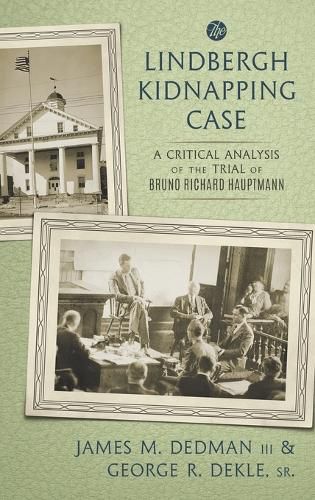Readings Newsletter
Become a Readings Member to make your shopping experience even easier.
Sign in or sign up for free!
You’re not far away from qualifying for FREE standard shipping within Australia
You’ve qualified for FREE standard shipping within Australia
The cart is loading…






This title is printed to order. This book may have been self-published. If so, we cannot guarantee the quality of the content. In the main most books will have gone through the editing process however some may not. We therefore suggest that you be aware of this before ordering this book. If in doubt check either the author or publisher’s details as we are unable to accept any returns unless they are faulty. Please contact us if you have any questions.
The First Book to Examine the Trial Itself
The kidnapping and murder of Charles A. Lindbergh, Jr. touched off one of the most massive manhunts in the history of American crime detection and generated so much publicity at home and abroad that it was touted as the Crime of the Century. The arrest of Bruno Richard Hauptmann in connection with the kidnapping inevitably led to the Trial of the Century. Although Hauptmann was almost universally detested at the time of the trial, the tide of public opinion began to change with his conviction. In the decades following Hauptmann’s execution, writers have advanced one theory after another seeking to pin the blame upon various members of the Lindbergh household and others. Almost every aspect of the crime and the investigation has been examined and critiqued–with one exception. No one has written a critical analysis of the trial itself. This book seeks to remedy that omission with an investigation and evaluation of the marshalling, presentation, and arguing of the evidence, and a study of the post-conviction litigation.
This innovative book includes:
a thorough analysis of the evidence presented at trial by both the prosecution and defense a comprehensive critique of the performance of the lawyers a discussion of inculpatory scientific evidence available to, but not used by, the prosecution a section listing the major protagonists in the investigation and trial a timeline a modular analysis of the prosecution case a table of cases
$9.00 standard shipping within Australia
FREE standard shipping within Australia for orders over $100.00
Express & International shipping calculated at checkout
This title is printed to order. This book may have been self-published. If so, we cannot guarantee the quality of the content. In the main most books will have gone through the editing process however some may not. We therefore suggest that you be aware of this before ordering this book. If in doubt check either the author or publisher’s details as we are unable to accept any returns unless they are faulty. Please contact us if you have any questions.
The First Book to Examine the Trial Itself
The kidnapping and murder of Charles A. Lindbergh, Jr. touched off one of the most massive manhunts in the history of American crime detection and generated so much publicity at home and abroad that it was touted as the Crime of the Century. The arrest of Bruno Richard Hauptmann in connection with the kidnapping inevitably led to the Trial of the Century. Although Hauptmann was almost universally detested at the time of the trial, the tide of public opinion began to change with his conviction. In the decades following Hauptmann’s execution, writers have advanced one theory after another seeking to pin the blame upon various members of the Lindbergh household and others. Almost every aspect of the crime and the investigation has been examined and critiqued–with one exception. No one has written a critical analysis of the trial itself. This book seeks to remedy that omission with an investigation and evaluation of the marshalling, presentation, and arguing of the evidence, and a study of the post-conviction litigation.
This innovative book includes:
a thorough analysis of the evidence presented at trial by both the prosecution and defense a comprehensive critique of the performance of the lawyers a discussion of inculpatory scientific evidence available to, but not used by, the prosecution a section listing the major protagonists in the investigation and trial a timeline a modular analysis of the prosecution case a table of cases